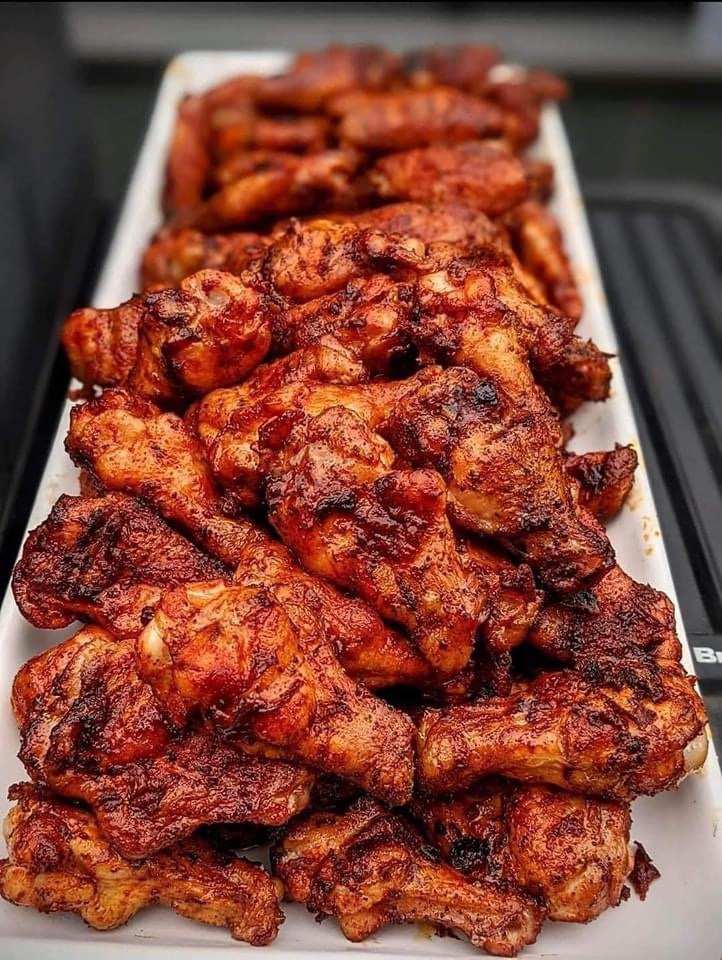Barbecued Chicken Wings

Ingredients:
2 pounds chicken wings
1 tablespoon paprika
1 tablespoon garlic powder
1 tablespoon onion powder
1 teaspoon salt
1 teaspoon pepper
1/2 cup unsalted butter, melted
1/4 cup hot sauce
Instructions:
Preheat your grill for indirect heat. You will need to set up a cooler side and a hotter side.
In a small bowl, mix together the paprika, garlic powder, onion powder, salt, and pepper.
Place the chicken wings in a large bowl and sprinkle the spice mixture over them, tossing to coat.
Place the chicken wings on the cooler side of the grill and smoke them for 1 hour, or until they are cooked through and the internal temperature reaches 165°F (74°C).
In a small bowl, mix together the melted butter and hot sauce.
Brush the wings with the butter mixture and move them to the hotter side of the grill. Grill the wings for an additional 5-10 minutes, or until they are crispy and caramelized.
Remove the wings from the grill and serve them hot, with your choice of dipping sauces or sides
The history of smoked chicken wings traces back to the traditional smoking techniques used by various cultures around the world. Smoking as a method of food preservation dates back thousands of years, with evidence of smoked meats found in archaeological sites from ancient civilizations.
In the context of chicken wings specifically, the popularity of smoked wings likely emerged in the United States, where barbecue and smoking techniques have deep cultural roots. Barbecue culture, particularly in regions like the Southern United States, has a rich history of slow-cooking meats over wood fires, resulting in tender and flavorful dishes.
The technique of smoking chicken wings involves slow-cooking them over indirect heat, allowing the wood smoke to impart a rich, smoky flavor to the meat while keeping it moist and tender. Over time, variations in seasoning and sauces have developed, reflecting regional preferences and culinary innovations.
Today, smoked chicken wings are a beloved dish enjoyed at barbecues, tailgate parties, and restaurants across the United States and beyond. They have become a staple menu item in many establishments, offering a flavorful alternative to traditional fried or grilled wings. The versatility of smoked wings also allows for experimentation with different wood types, seasonings, and sauces, adding to their appeal among food enthusiasts.
In addition to their origins in traditional smoking techniques and barbecue culture, smoked chicken wings have evolved over time to become a versatile and popular dish in contemporary cuisine.
The rise of barbecue competitions and festivals in the United States has contributed to the popularity and refinement of smoked chicken wings. Pitmasters and chefs continually experiment with different wood varieties, such as hickory, mesquite, applewood, and cherry, each imparting its own unique flavor profile to the wings.
Furthermore, the accompanying seasonings and sauces used in smoked chicken wings have diversified, catering to a wide range of tastes and preferences. While the classic combination of paprika, garlic powder, onion powder, salt, pepper, butter, and hot sauce remains a favorite, variations incorporating ingredients like honey, maple syrup, bourbon, or Asian-inspired spices have emerged, offering a creative twist to the traditional recipe.
The widespread availability of smoking equipment, such as smokers, pellet grills, and charcoal grills with smoker boxes, has also contributed to the accessibility of smoked chicken wings for home cooks and enthusiasts. This accessibility has led to a proliferation of online recipes, cooking tutorials, and communities dedicated to mastering the art of smoking wings.
Moreover, the popularity of smoked chicken wings has extended beyond traditional barbecue establishments to include gastropubs, sports bars, and even fine dining restaurants. Chefs and cooks continue to innovate with presentation and serving styles, incorporating smoked wings into appetizer platters, salads, sliders, and even tacos, showcasing their versatility in a variety of culinary contexts.
Overall, the evolution of smoked chicken wings reflects a combination of historical tradition, culinary creativity, and contemporary gastronomic trends, making them a beloved and enduring dish enjoyed by people of all ages and backgrounds.
Enjoy


